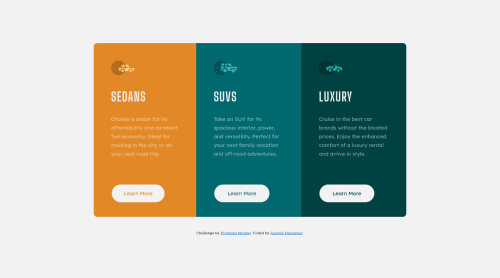3 Column Card Challenge. with HTML SCSS

Solution retrospective
Hi frontend mentor community 🤗, this is my second challenge here! any feedbacks are welcome.
have a great day! 😚
Please log in to post a comment
Log in with GitHubCommunity feedback
- @kens-visuals
Hey @JoaquinDeveloper 👋🏻
I have some suggestion to help you fix the accessibility, HTML and some other issues.
- I'd suggest replacing
<section>s with<div>s, because when you use<section>you have to have a heading in it. Besides that<section>is for bigger things in a layout, such as, about us section, contact us, gallery, etc. Don't forget to generate a new report once you fix the issues. - For the car icons, add
aria-hidden="true”, because they are for decoration only. You can read more aboutaria-hiddenhere. - When it comes to
:hoverstates, you can apply them directly to the class, instead of:nth-child, and in this case when you have to use different background colors use can use modifier classes to help you. If you're familiar withBEMnaming convention than you know what I mean by modifier, if not check out this link. - For the mobile viewport width, I suggest reducing
widthof.card-infoto90%and addingmargin-topofbuttons to100px, so you don't have too much white space at the bottom.
I hope this was helpful 👨🏻💻 congrats on finishing the second project, well done. Cheers 👾
Marked as helpful - I'd suggest replacing
- @JoaquinDeveloper
hey @kens_visuals 🖐🏻 , first of all thanks for taking the time to look at my work, I didn't know anything about the aria-hidden so thanks for that im implement in the future. 😋 about <section> tag I wasn't sure how to use but with your comment I have it clear. 😁
Cheers 🙋🏻♂️
Join our Discord community
Join thousands of Frontend Mentor community members taking the challenges, sharing resources, helping each other, and chatting about all things front-end!
Join our Discord